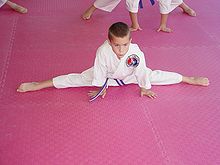Split (gymnastics)


A split is a physical position in which the legs are in line with each other and extended in opposite directions. Splits are performed in various athletic activities, including dance, figure skating, gymnastics, martial arts, contortionism, synchronized swimming, cheerleading and yoga. A person who has assumed a split position is said to be "in a split."[1]
When executing a split, the lines defined by the inner thighs of the legs form an unusually large angle of approximately 180 degrees. This large angle significantly stretches, and thus demonstrates excellent flexibility of, the hamstring and iliopsoas muscles. Consequently, splits are often used as a stretching exercise to warm up and enhance the flexibility of leg muscles.
Variations
There are two general forms of splits:
- Side splits are executed by extending the legs to the left and right of the torso. Side splits are called straddle splits in dance and yoga, and may be referred to as Chinese splits in martial arts. Other names for side splits are box splits and center splits.
- Front splits are executed by extending one leg forward of, and the other leg to the rear of the torso. In dance, a front split is named according to the leg that is extended forward (e.g., the right leg is extended forward when executing a right split). Front splits require hyper-extension of the iliofemoral ligament, otherwise the majority of the range of motion must come from the front hip joint.[clarification needed]
There are many variations of form and performance of splits, including:
- Oversplit, in which the angle between the legs exceeds 180 degrees.
- Suspended split, in which the body is static and supported only by the feet.
- A split leap or split jump is a split that is executed after leaping or jumping, respectively, while still in the air. In figure skating, split jumps are sometimes called Russian jumps. These are sometimes done as an exercise.
- Standing split or vertical split, in which the leg lines are oriented vertically.
- Twisting splits are performed by transitioning from front split to side split, and then to the opposite front split.
- Martial arts split is a front split in which the back leg is rotated so the inside edge of the foot rests on the ground. It is more commonly named a "half split".
-
An acro dancer performing a straddle split leap.
-
A standing split during a figure skating spin.
-
An oversplit.
-
Monkey pose
Problems associated with splits
A common problem encountered during a side split is pain in the hip joints. Usually, the reason for this is that the split is being performed improperly (the pelvis may need to be tilted forward). Another common problem encountered during splits (both front and side) is pain in the knees.[2]
Yoga
The legs are in a front split position in the yoga poses Hanumanasana and Kākāsana (the latter is suspended and the front knee is flexed).
Popular culture
Most people lack the flexibility required to execute a split and thus regard splits to be uncomfortable or even painful. Because of this widespread view, splits appear in slapstick comedy, schadenfreude, and other forms of entertainment.
Actor Jean-Claude Van Damme is known for his ability to do suspended splits. Professional wrestler Rob Van Dam invented the "Van Dam lift", in which he lifted weights while in a suspended split; other professional wrestlers; such as Melina Perez, Santino Marella, and Ron Killings; have helped to popularize the split. Former Pussycat Dolls Kimberly Wyatt and Carmit Bachar are notable for their standing oversplits. Model Karen McDougal is notable for her straddle split.
References
- ^ Oxford English Dictionary, split, n. "4 b. the splits, in acrobatics or stage-dancing. Also in sing."
- ^ Performing splits,http://www.runtheplanet.com/trainingracing/stretching/chap4-splits.asp



